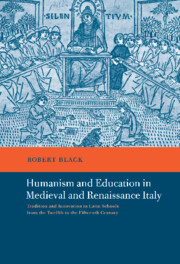 Humanism and Education in Medieval and Renaissance Italy
Humanism and Education in Medieval and Renaissance Italy Book contents
- Frontmatter
- Contents
- Acknowledgements
- List of abbreviations
- Editorial note regarding citations from manuscripts and publications
- A note on chronological terminology
- Introduction
- 1 Italian Renaissance education: an historiographical perspective
- 2 The elementary school curriculum in medieval and Renaissance Italy: traditional methods and developing texts
- 3 The secondary grammar curriculum
- 4 Latin authors in medieval and Renaissance Italian schools: the story of a canon
- 5 Reading Latin authors in medieval and Renaissance Italian schools
- 6 Rhetoric and style in the school grammar syllabus
- Conclusion
- Appendix I BL Harley 2653: the earliest known manuscript of Ianua
- APPENDIX II A handlist of manuscripts of Ianua
- Appendix III Manuscripts of Tebaldo's Regule
- Appendix IV Handlist of manuscripts of school authors produced in Italy and now found in Florentine libraries
- Appendix V Theoretical grammar manuscripts in Florentine libraries examined and included or eliminated as italian school grammars
- Appendix VI Authorities Cited Explicitly in Manuscripts of Major School Authors in Florentine Libraries
- Bibliography
- Index of manuscripts
- General index
4 - Latin authors in medieval and Renaissance Italian schools: the story of a canon
Published online by Cambridge University Press: 25 July 2009
- Frontmatter
- Contents
- Acknowledgements
- List of abbreviations
- Editorial note regarding citations from manuscripts and publications
- A note on chronological terminology
- Introduction
- 1 Italian Renaissance education: an historiographical perspective
- 2 The elementary school curriculum in medieval and Renaissance Italy: traditional methods and developing texts
- 3 The secondary grammar curriculum
- 4 Latin authors in medieval and Renaissance Italian schools: the story of a canon
- 5 Reading Latin authors in medieval and Renaissance Italian schools
- 6 Rhetoric and style in the school grammar syllabus
- Conclusion
- Appendix I BL Harley 2653: the earliest known manuscript of Ianua
- APPENDIX II A handlist of manuscripts of Ianua
- Appendix III Manuscripts of Tebaldo's Regule
- Appendix IV Handlist of manuscripts of school authors produced in Italy and now found in Florentine libraries
- Appendix V Theoretical grammar manuscripts in Florentine libraries examined and included or eliminated as italian school grammars
- Appendix VI Authorities Cited Explicitly in Manuscripts of Major School Authors in Florentine Libraries
- Bibliography
- Index of manuscripts
- General index
Summary
MAJOR AND MINOR AUTHORS
The study of the Latin authors was the principal activity of Roman grammar schools, and this educational tradition was handed down to the middle ages. Beginning in the high middle ages there was a tendency to distinguish two types of authors, major and minor, as Conrad of Hirsau (c. 1070–c. 1150) suggests in his Dialogus super auctores. Which authors Conrad considers to be major or minor becomes clearer from the context. As minores suitable for ‘rudimentis parvulorum’, there are the grammarian Donatus, Cato (an anthology of philosophical sententiae in distichs and monostichs, dating from imperial Rome), Aesop (the late antique collection of fables in prose) and Avianus (forty-two fables in distichs, written c. 400); next come the Christian poets Sedulius (the fifth-century writer of the Paschale carmen), Juvencus (the author of an hexameter life of Christ), Prosper of Aquitaine (who versified some sententiae of Augustine in the earlier fifth century) and Theodulus (an unknown author of a tenth-century eclogue contrasting paganism and Christianity). Conrad is not explicit about the maiores, but having treated the minores, he says, ‘Veniamus nunc ad romanos auctores’: here he includes Arator (the sixth-century author of a hexametrical version of the Book of Acts), Prudentius (the outstanding early Christian poet, writing at the turn of the fifth century), Cicero, Sallust, Boethius, Lucan, Vergil and Horace; subsequently he also discusses Ovid, Juvenal, Ilias latina (a reduction of the Iliad to 1070 hexameters, made possibly in the first century ad by Baebius Italicus), Persius and Statius.
- Type
- Chapter
- Information
- Humanism and Education in Medieval and Renaissance ItalyTradition and Innovation in Latin Schools from the Twelfth to the Fifteenth Century, pp. 173 - 274Publisher: Cambridge University PressPrint publication year: 2001
